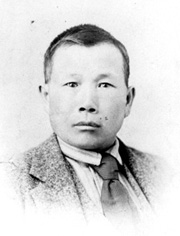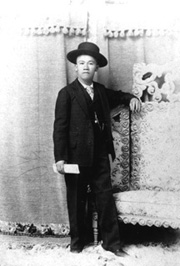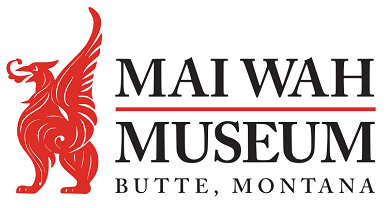Tommie Haw
 In 1886, Montana pioneer Johnny Grant returned from Canada to collect old debts and visit friends. In his journals, he lists the names of the whites he stayed with along the way, who opened their homes to him and offered their hospitality. With one exception. Grant mentions a Chinaman who owned a ranch south of Butte with two white men working for him.
In 1886, Montana pioneer Johnny Grant returned from Canada to collect old debts and visit friends. In his journals, he lists the names of the whites he stayed with along the way, who opened their homes to him and offered their hospitality. With one exception. Grant mentions a Chinaman who owned a ranch south of Butte with two white men working for him.
He writes about the hospitality of a Chinaman who fed him, gave him shelter, and gave him a bale of hay to take along for his horse.
When Grant asked how much he owed him, the Chinaman replied “Nothing, nothing, when you see a Chinaman in need, give him a meal.” That Chinaman was most likely Tommie Haw, one of the first settlers of the Dillon area.
The story of how Tommie Haw actually came to Montana has been muddled by time. One story relates how he was an orphan in San Francisco in 1850 when a cattle rancher named Tom Orr spotted him staring in the window of a restaurant. Orr took pity and adopted the orphan. Because the boy had trouble pronouncing his new last name, he became known as Tommie Haw.
When Tom Orr’s brother, William, brought the first cattle herds to the Beaverhead Valley to bring fresh beef to the area’s gold miners, he brought along Tommie. Another story tells that he was hired in California as a cook and came along on the trail to Montana.
A third story relates that Haw was found after an Indian massacre near Yreka. There is no record of any Indian massacre occuring near Yreka, according to the Siskiyou County Historical Museum in California.
Yet another story tells how the little Chinese boy was the sole survivor of an Indian massacre that Orr encountered along the trail to bringing cattle to the Beaverhead Valley.
According to early newspaper reports, a massacre of 49 Chinese by hostile Paiutes did occur during the summer of 1866 near the Owyhee Crossing in Idaho near where Orr passed through from California on his way to the Beaverhead. There was only one Chinese survivor and that may have been Tommie Haw.
 What is known for sure is that Tommie came to Montana on the first cattle drive into the Beaverhead with the Orrs and was raised there almost as a son. William Orr’s wife taught Tommy math and to read and write English. As Tommie grew into manhood, like Orr’s other sons, he soon had his own herd of cattle, and his own brand, O C (Orr’s Chinaman).
What is known for sure is that Tommie came to Montana on the first cattle drive into the Beaverhead with the Orrs and was raised there almost as a son. William Orr’s wife taught Tommy math and to read and write English. As Tommie grew into manhood, like Orr’s other sons, he soon had his own herd of cattle, and his own brand, O C (Orr’s Chinaman).
Tommie Haw later sold his cattle herd for $9,000 and bought into a sheep ranch with a partner, William Jones. Together they leased a ranch and raised sheep, running sheep in Montana and Idaho, and retiring from that business with a modest fortune.
Afterwards, Tommie invested in mining properties and lost most of his savings except for a few thousand dollars which he bequeathed to women who cared for him in his last months. He died in July 1913 at the age of 70 of “stomach trouble” while living in the Kunzman Block in Dillon.
His funeral was an event. His pallbearers included four sons of Willam Orr and the procession to the Poindexter Cemetery north of town included many friends from a long life on the frontier. He was buried next to the Orr family lot. His obituary concluded that “He was a big-hearted, honest, industrious and charitable man” and the “whitest Chinaman who ever lived,” which was more a comment on the prevailing opinion of Chinese.
Today, the Beaverhead County Museum in Dillon devotes a display to Haw and other Chinese immigrants to the Dillon area.
